| Srl | Item |
| 1 |
ID:
114376


|
|
|
| 2 |
ID:
114831
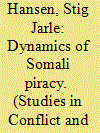

|
|
|
|
|
| Publication |
2012.
|
| Summary/Abstract |
By drawing upon information gathered from interviews with pirates as well as statistics this article explores the major traits of contemporary piracy in Somalia and the how they developed. Criminal maritime groups in the country have traditionally been the product of the actions and decisions of individual actors, although the current wave of activity is more the result of the weakening of political institutions. In all cases syndicates are driven by profit considerations and have largely shunned connections with political entities-although this latter factor appears to have changed since the end of 2010.
|
|
|
|
|
|
|
|
|
|
|
|
|
|
|
|
| 3 |
ID:
091170
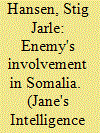

|
|
|
|
|
| Publication |
2009.
|
| Summary/Abstract |
Supporting allies in a conflict in foreign lands is an adventure fraught with difficulty. As imperial powers regularly discovered, local powerbrokers can often incite violent opposition that undermines any influence they have. Moreover, the ability to control proxies, who often come saddled with their own personal amitions and enemies, is limited, meaning even if they are successful in brokering power, they may pursue policies antithetical to the patron state. The fact that the anti-Soviet mujahideen in Afghanistan were materially supported by the United States in the 1980s, and went on to forge both Al-Qaeda and the Taliban, is a current example of the dangers of proxy support.
|
|
|
|
|
|
|
|
|
|
|
|
|
|
|
|
| 4 |
ID:
075621
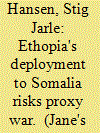

|
|
|
| 5 |
ID:
114835


|
|
|
|
|
| Publication |
2012.
|
| Summary/Abstract |
How does a sector consisting of a variety of owners cooperate to create effective anti-piracy tactics? This article describes how security strategies in the shipping industry have evolved, worked and what lessons need to be applied when formulating responses to future threat contingencies.
|
|
|
|
|
|
|
|
|
|
|
|
|
|
|
|
| 6 |
ID:
094324
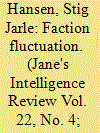

|
|
|
| 7 |
ID:
184182
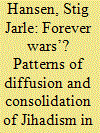

|
|
|
|
|
| Summary/Abstract |
The article will discuss the patterns that jihadism has followed when spreading throughout sub-Saharan Africa, addressing the major scholarly debates but also to bring forward the elements that various African cases seemingly have in common. The discussions over African Jihadism has seen several great debates, over the ungoverned space theory, a dichotomous discussion of the local and the global as opposing explanatory models, and a discussion of the role of ‘greed’ and economic incentives. The article argues that these discussions need to be transcended, and that dichotomous discussions fail to see more complex patterns of interaction between various factors, and the complexity of social relations that at times depend on the different contexts we study. Understanding how global networks can harness local conflicts to gain support is key to understanding African jihadist groups, and how those harnessing strategies can be limited. The article also suggests that there is an emerging consensus over several of the factors that do occur in sub-Saharan African jihadism and present the implications of these findings for the ongoing conflict in Mozambique and Tanzania.
|
|
|
|
|
|
|
|
|
|
|
|
|
|
|
|
| 8 |
ID:
087860
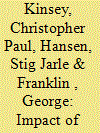

|
|
|
|
|
| Publication |
2009.
|
| Summary/Abstract |
The article discusses the use of private security contractors to support coastguard forces in the Somali substate entities of Puntland and Somaliland. Neither of these entities is sufficiently robust to raise and maintain an effective maritime security force without external assistance, hence they have had recourse to the private sector for training, logistical and operational support and high-level consultancy with respect to their coastguards. The article makes some general observations about the international private security industry and Somali politics in order to provide a context for the three case studies. The case studies, each of which covers the engagement of one security contractor in support of a coastguard, assess the roles played by the contractors, making particular reference to sustainability and influence on governance networks. The analysis establishes a matrix of security company typologies and potential roles and then uses this matrix to suggest which types of company might be best employed for which functions. The article has current pertinence, as two of the three case studies concern efforts by substate entities to hire private security to enhance anti-piracy capability.
|
|
|
|
|
|
|
|
|
|
|
|
|
|
|
|
| 9 |
ID:
085056
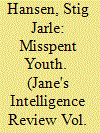

|
|
|
| 10 |
ID:
114829
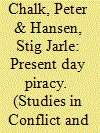

|
|
|
|
|
| Publication |
2012.
|
| Summary/Abstract |
Why has international piracy re-emerged as a threat to international shipping? The article introduces the factors that influence modern piracy, and explore the causes of it in more general terms. This introduction provides an overview of the scope and dimensions of modern-day piracy. It looks at problems of definition, statistics, location of attacks and main drivers. The article suggests that there is a limited set of geographical clusters that drive contemporary piracy, each of which require their own unique and separate national and international counter-measures.
|
|
|
|
|
|
|
|
|
|
|
|
|
|
|
|
| 11 |
ID:
097136
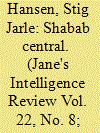

|
|
|
| 12 |
ID:
053982
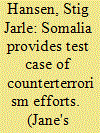

|
|
|
| 13 |
ID:
161539
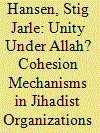

|
|
|
|
|
| Summary/Abstract |
This article explores mechanisms fostering cohesion in jihadist organizations in relation to territorial presence. This article takes four types of territorial presence as its point of departure: (1) a clandestine network-based presence; (2) an accepted presence where the organization is tolerated by a state; (3) a semiterritorial presence, where the organization is allowed some control between phases of enemy offensives and withdrawals; and (4) a relatively permanent territorial presence, where the organization fully controls the territory in which it has bases. The article argues that each of these types of territorial presence opens up for different ways for organizations to create cohesion. Cohesion mechanisms thus vary according to type of territorial presence.
|
|
|
|
|
|
|
|
|
|
|
|
|
|
|
|